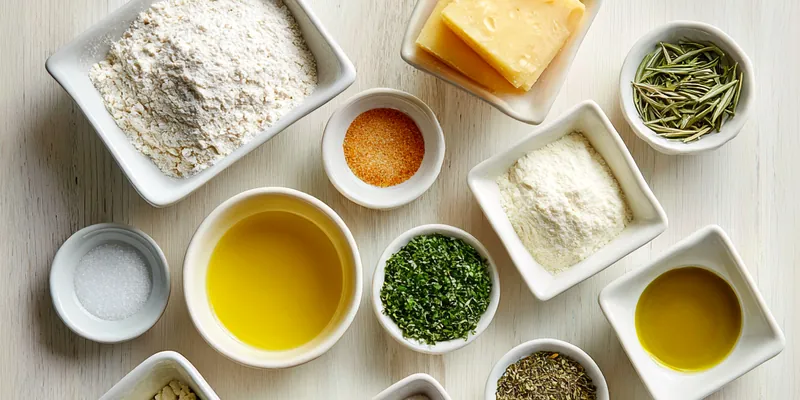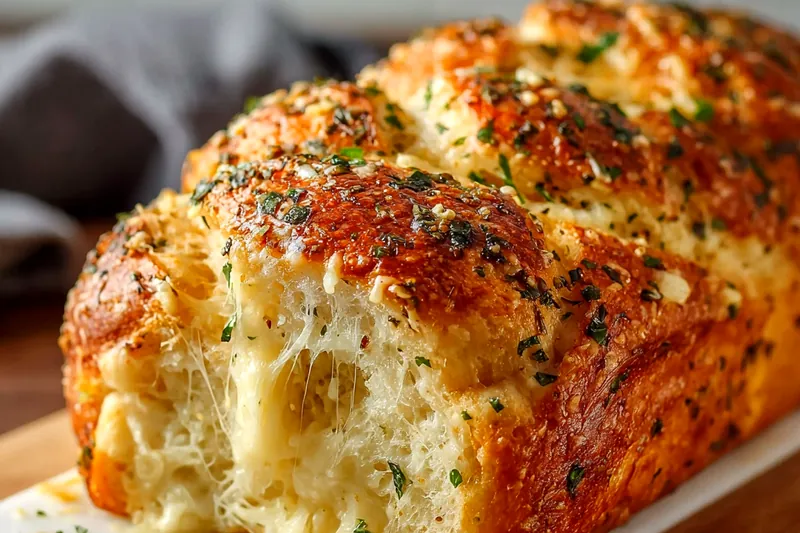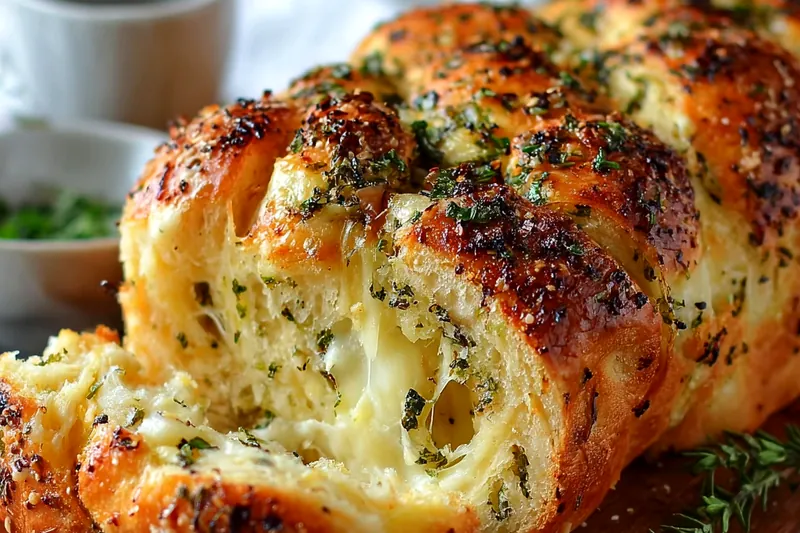Baked Italian Herb and Cheese Bread Loaf
Aromatic homemade Italian herb and cheese bread loaf with a golden crust and soft, flavorful interior. Perfect for dinner parties or cozy family meals.

Mastering Yeast Bread Fundamentals
The foundation of exceptional herb and cheese bread lies in understanding yeast behavior and proper dough development. Active dry yeast needs the right temperature and environment to create the lift and texture that makes homemade bread superior to store-bought versions.
Proper kneading develops the gluten structure that gives bread its characteristic chew and allows it to hold the herb and cheese filling without falling apart. The dough should be smooth, elastic, and slightly tacky but not sticky when properly developed.
💡 Professional Tip
Test your water temperature with a thermometer - too hot kills yeast, too cool won't activate it. The water should feel barely warm to your wrist, around 110°F (43°C).
Frequently Asked Questions
Yes, use 2/3 the amount of instant yeast and mix it directly with the flour. No need to proof it first, but the rise times may be slightly shorter.
The dough should double in size and spring back slowly when poked with a finger. If it springs back quickly, it needs more time. If it doesn't spring back, it may be over-proofed.
Absolutely! This bread is designed to be made by hand. Knead on a floured surface for 8-10 minutes until the dough is smooth and elastic.
Create a warm environment by placing the bowl on top of the refrigerator, near (not on) a warm stove, or in an oven with just the light on.
Yes, wrap cooled bread tightly in plastic wrap and foil. Freeze for up to 3 months. Thaw at room temperature and refresh in a 350°F oven for 5-10 minutes.
Brush with melted butter and sprinkle with coarse salt before baking. For an even crustier loaf, place a pan of hot water on the bottom oven rack during the first 15 minutes of baking.
Yes! Try provolone, asiago, or fontina. Avoid very wet cheeses like fresh mozzarella as they can make the bread soggy. Stick to about 2 cups total cheese.
Store at room temperature in a bread bag or wrapped in a clean kitchen towel for up to 3 days. Avoid plastic bags which make the crust soft.
Recipe Troubleshooting Guide
Dense, Heavy Bread
Problem: Bread turns out dense instead of light and airy
Solution: Check yeast freshness, ensure proper rising times, and don't add too much flour during kneading. The dough should be slightly tacky, not completely dry.
Yeast Won't Activate
Problem: Yeast mixture doesn't foam or bubble
Solution: Check water temperature (should be 110°F), verify yeast expiration date, and ensure sugar is added to feed the yeast. Start over with fresh ingredients if needed.
Filling Leaks Out
Problem: Cheese and herbs leak out during baking
Prevention: Don't overfill, roll tightly but not so tight the dough tears, and ensure seam is well-sealed. Pinch edges firmly before placing in pan.
Pale or Soft Crust
Problem: Bread doesn't develop a golden, crusty exterior
Recovery: Brush with melted butter before baking, increase oven temperature by 25°F, or move to upper oven rack for the last 10 minutes of baking.
Over-Proofed Dough
Problem: Dough rises too much and collapses
Prevention: Punch down gently and reshape. Let rise again for 15-20 minutes. Over-proofed bread may be slightly dense but still edible.
Flavor Balance Issues
Too Sweet: Add more garlic, herbs, or a pinch of black pepper
Too Salty: Balance with a drizzle of honey or serve with sweet butter
Bland: Increase fresh herbs, add more garlic, or brush with herb-infused oil after baking

Selecting Quality Bread Making Ingredients
The quality of flour significantly impacts your bread's texture and flavor. Bread flour contains more protein than all-purpose flour, creating stronger gluten development for better rise and chew. If using all-purpose flour, expect a slightly more tender crumb.
Fresh herbs make an enormous difference in flavor compared to dried alternatives. The combination of basil, oregano, and rosemary creates the classic Italian herb profile, while high-quality cheeses ensure proper melting and rich taste throughout the loaf.
Essential Ingredient Notes
- Yeast Freshness: Check expiration dates on yeast packages. Store opened yeast in the refrigerator and bring to room temperature before using. Foaming during activation is your freshness test.
- Herb Quality: Fresh herbs provide superior flavor and aroma. If using dried herbs, use 1/3 the amount and add them to the flour mixture for even distribution.
- Cheese Selection: Use low-moisture mozzarella to prevent soggy bread. Freshly grated Parmesan provides better flavor and melting than pre-grated varieties.

Perfecting the Bread Baking Process
Temperature control is crucial throughout the bread-making process. From activating yeast to final baking, each stage requires specific conditions for optimal results. The final internal temperature of 190°F ensures the bread is fully cooked without being dry.
The rolling and shaping technique distributes herbs and cheese evenly while creating attractive swirls throughout the loaf. Proper sealing prevents filling from escaping while maintaining the loaf's structural integrity during baking.
The Perfect Roll
Roll the dough evenly but not too tightly - you want to create layers without tearing the dough. A gentle, consistent pressure ensures even distribution of fillings.
Baked Italian Herb and Cheese Bread Loaf
📋 Ingredients
For the Bread Dough
- 150g shredded mozzarella cheeseLow-moisture variety preferred
- 60g grated Parmesan cheeseFreshly grated for best flavor
- 15g fresh basil, choppedKey aromatic herb
- 15ml fresh oreganoOr 1 tsp dried
- 15ml fresh rosemary, choppedOr 1 tsp dried
- 3 cloves garlic, mincedFresh garlic essential
- Coarse sea saltFor finishing touch
For the Herb and Cheese Filling
- 500g bread flourHigher protein for better rise
- 7g active dry yeastCheck expiration date
- 320ml warm water (110°F)Temperature is crucial
- 15ml sugarFeeds the yeast
- 12ml saltEnhances flavor and structure
- 45ml olive oilDivided for dough and brushing
- 30g melted butterFor golden finish
Instructions
Activate the Yeast
In a small bowl, combine warm water, sugar, and yeast. Let stand for 5-10 minutes until foamy and bubbly. If mixture doesn't foam, start over with fresh yeast.
Make the Dough
In a large bowl, combine flour, salt, garlic powder, onion powder, and Italian seasoning. Add the yeast mixture and 2 tablespoons olive oil. Mix until a shaggy dough forms, then knead on floured surface for 8-10 minutes until smooth and elastic.
First Rise
Place dough in an oiled bowl, cover with damp towel, and let rise in warm place for 1-1.5 hours until doubled in size. The dough should spring back slowly when poked.
Shape and Fill
Punch down dough and roll into a 12x16 inch rectangle. Brush with remaining olive oil, sprinkle with minced garlic, fresh herbs, mozzarella, and Parmesan. Roll tightly from long side, pinch seam to seal, and place seam-side down in greased 9x5 inch loaf pan.
Final Rise and Bake
Cover and let rise for 30-45 minutes until dough crowns the pan. Preheat oven to 375°F (190°C). Brush top with melted butter and sprinkle with coarse salt. Bake for 30-35 minutes until golden brown and internal temperature reaches 190°F (88°C). Cool in pan for 10 minutes before removing.
Recipe Notes & Tips
Storage
Store at room temperature wrapped in a clean kitchen towel for up to 3 days. For longer storage, slice and freeze wrapped in plastic and foil for up to 3 months.
Serving Suggestions
Serve warm with butter, alongside pasta dishes, soups, or as part of an Italian antipasto spread. This bread also makes excellent sandwiches or toast.
Variations
Try different herb combinations like thyme and sage, add sun-dried tomatoes, or experiment with different cheeses like provolone or fontina for unique flavor profiles.
